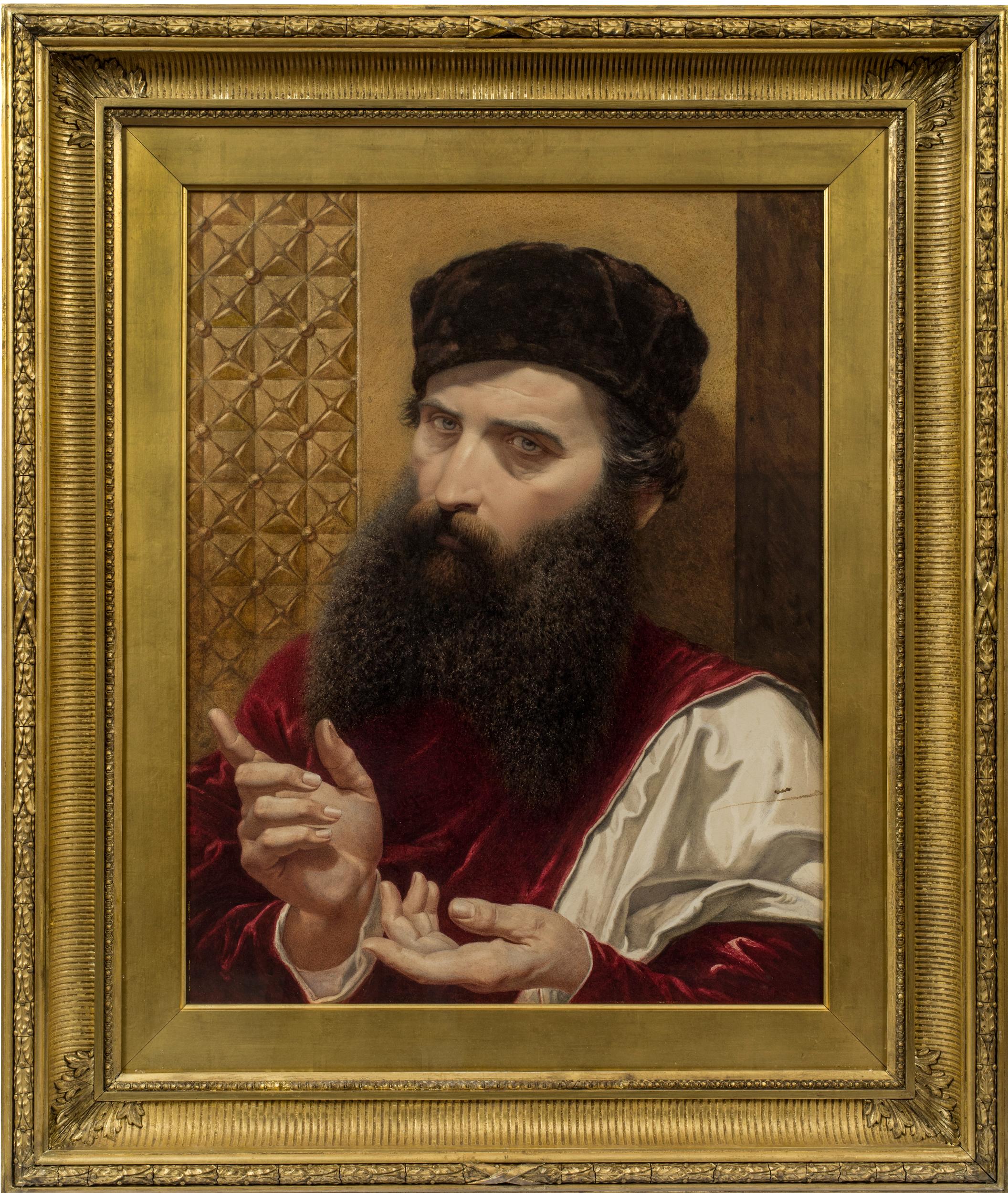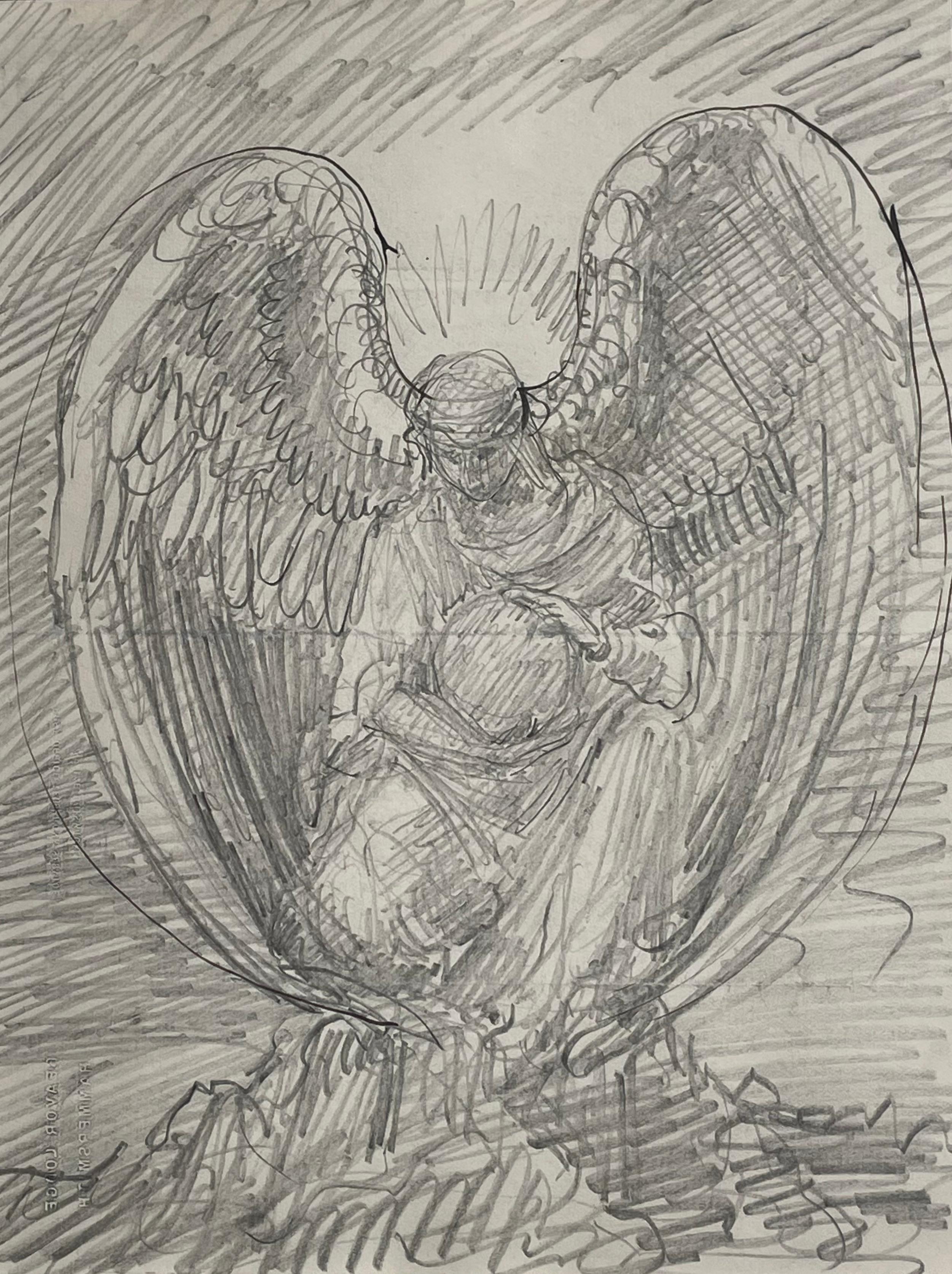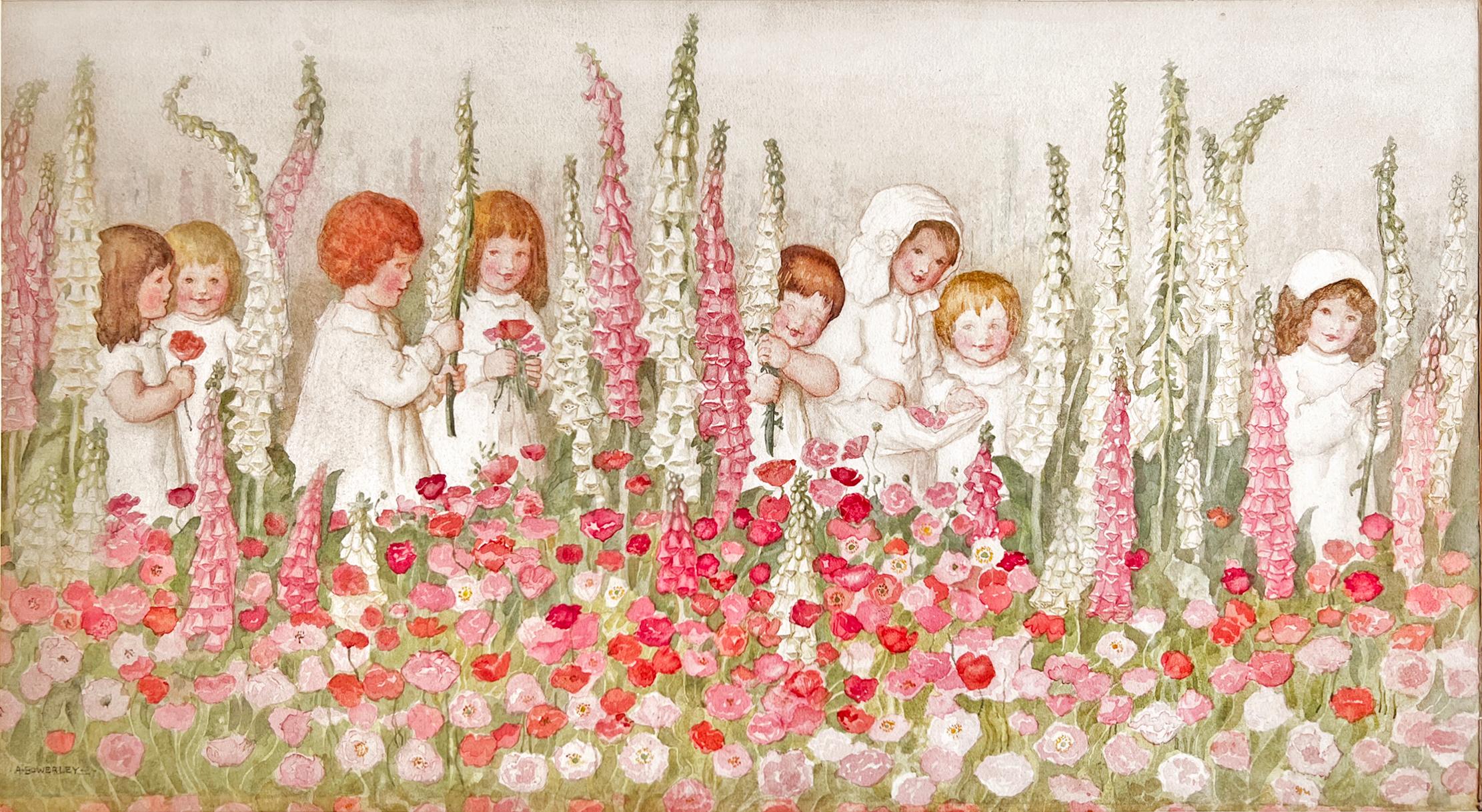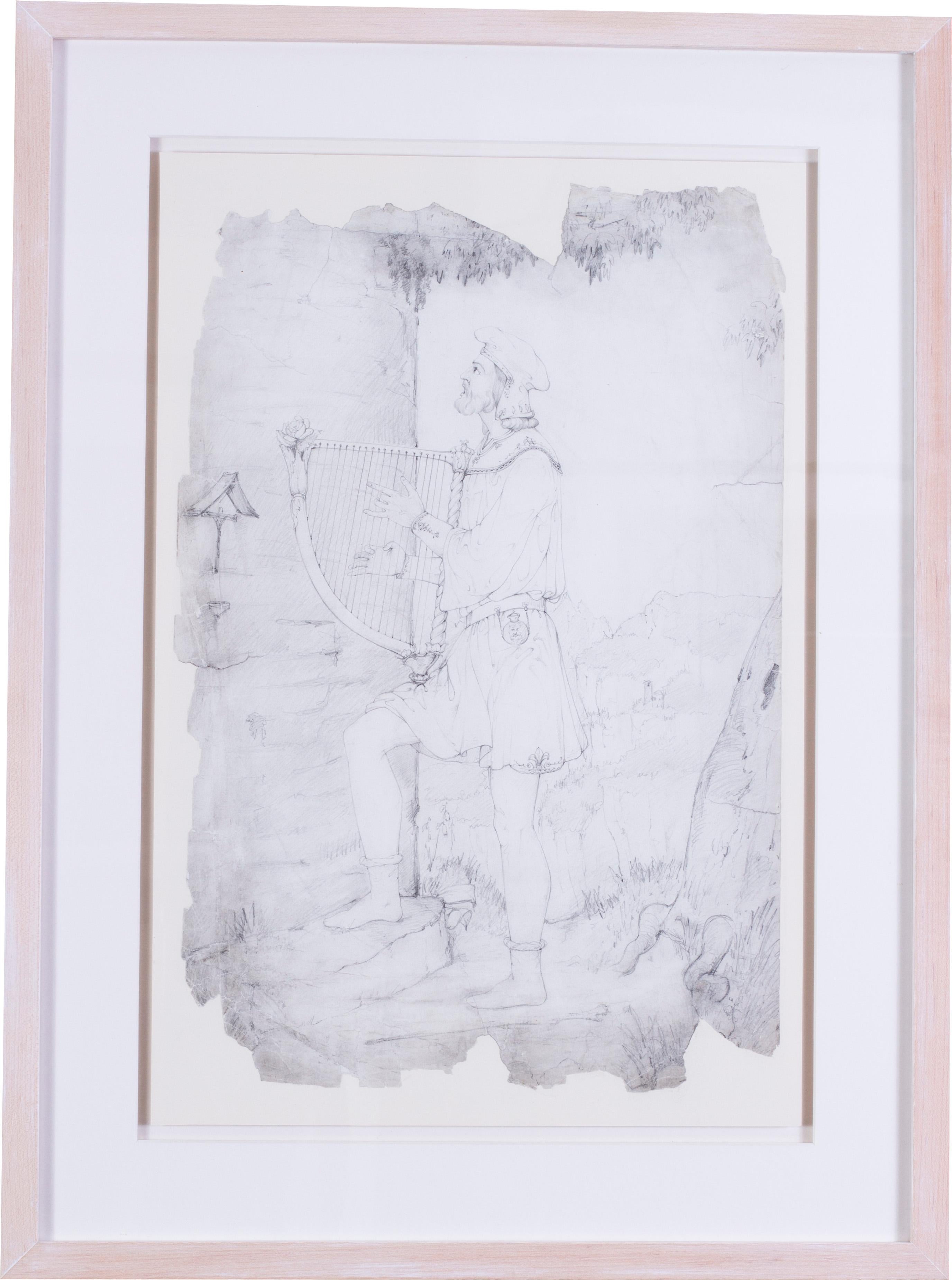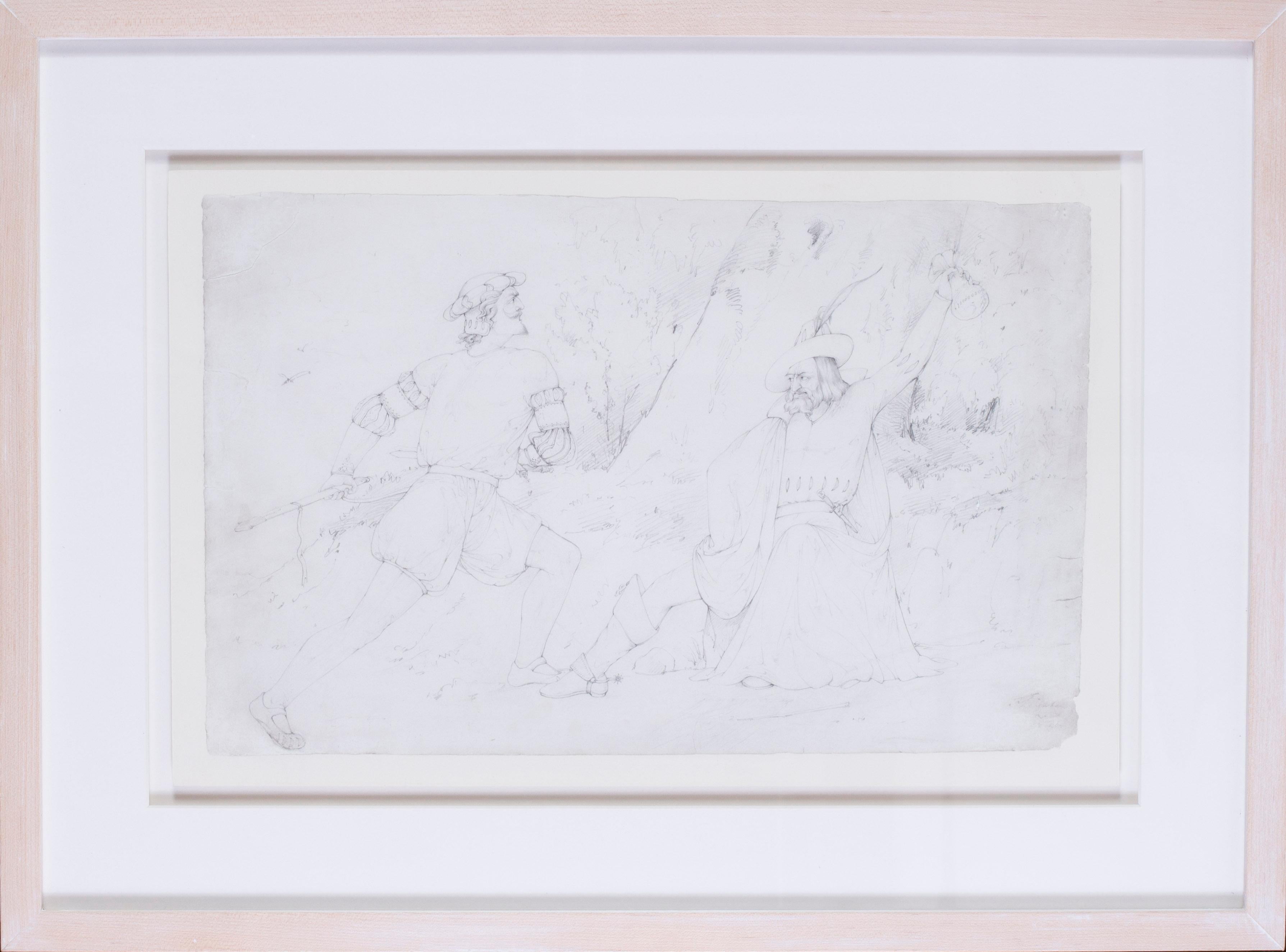Items Similar to Studies for a historic scene painting
Want more images or videos?
Request additional images or videos from the seller
1 of 9
Daniel MacliseStudies for a historic scene paintingn.d.
n.d.
About the Item
Studies for a historic scene painting
Graphite on paper, c. 1860's
Sheet size: 12 3/8 x 19 inches
Unsigned
Provenance: J S Maas & Co., London (see label)
Denys Sutton, London, noted art historian and scholar
Christie's (label)
Exhibited: J.S. Mass & Co. Ltd., Bond Street, London
Note: Maclise, an Irishman, was well regarded in London art circles. He is best known for historical scenes and series of murals that he executed in Westminster Palace. The studies on this sheet are typical of the romantic, almost Pre-Raphaelite imagery of the times.
Daniel Maclise RA (25 January 1806 – 25 April 1870) was an Irish history painter, literary and portrait painter, and illustrator, who worked for most of his life in London, England.
Early life
Maclise was born in Cork, Ireland, the son of Alexander McLish (also known as McLeish, McLish, McClisse or McLise), a tanner or shoemaker, but formerly a Scottish Highlander soldier. His education was of the plainest kind, but he was eager for culture, fond of reading, and anxious to become an artist. His father, however, placed him in employment, in 1820, in Newenham's Bank, where he remained for two years, before leaving to study at the Cork School of Art. In 1825 it happened that Sir Walter Scott was travelling in Ireland, and young Maclise, having seen him in a bookseller's shop, made a surreptitious sketch of the great man, which he afterwards lithographed. It became very popular, and led to many commissions for portraits, which he executed, in pencil.
Various influential friends recognised Maclise's genius and promise, and were anxious to furnish him with the means of studying in London; but refusing all financial assistance, he saved the money himself and arrived in the capital on 18 July 1827. There he made a sketch of Charles John Kean, the actor, which, like his portrait of Scott, was lithographed and published, making the artist a considerable sum. He entered the Royal Academy schools in 1828, eventually being awarded the highest prizes open to students.
Career
Maclise exhibited for the first time at the Royal Academy in 1829. Gradually he began to confine himself more exclusively to subject and historical pictures, varied occasionally by portraits – such as those of Lord Campbell, novelist Letitia Landon, Dickens, and other of his literary friends. In 1833, he exhibited two pictures which greatly increased his reputation, and in 1835 the Chivalric Vow of the Ladies and the Peacock procured his election as associate of the Academy, of which he became full member in 1840. The years that followed were occupied with a long series of figure pictures, deriving their subjects from history and tradition and from the works of Shakespeare, Goldsmith and Le Sage.
He also designed illustrations for several of Dickens's Christmas books and other works. Between the years 1830 and 1836 he contributed to Fraser's Magazine, under the pseudonym of Alfred Croquis, a remarkable series of portraits of the literary and other celebrities of the time – character studies, etched or lithographed in outline, and touched more or less with the emphasis of the caricaturist, which were afterwards published as the Maclise Portrait Gallery (1871). During the rebuilding of the Houses of Parliament in London in 1834–1850 by Charles Barry, Maclise was commissioned in 1846 to paint murals in the House of Lords on such subjects as Justice and Chivalry.
In 1858, Maclise commenced one of the two great monumental works of his life, The Meeting of Wellington and Blücher after the Battle of Waterloo, on the walls of Westminster Palace. It was begun in fresco, a process which proved unmanageable. The artist wished to resign the task, but, encouraged by Prince Albert, he studied in Berlin the new method of water-glass painting, and carried out the subject and its companion, The Death of Nelson, in that medium, completing the latter painting in 1864.
Maclise's vast painting of The Marriage of Strongbow and Aoife (1854) hangs in the National Gallery of Ireland, Dublin. It portrays the marriage of the main Norman conqueror of Ireland "Strongbow" to the daughter of his Gaelic ally. By the grand staircase of Halifax Town Hall, which was completed in 1863, there is a wall painting by Maclise.
The intense application which he gave to these great historic works, and various circumstances connected with the commission, had a serious effect on the artist's health. He began to shun the company in which he formerly delighted, his old buoyancy of spirits was gone, and when, in 1865, the presidency of the Royal Academy was offered to him he declined the honour. He died of acute pneumonia on 25 April 1870 at his home 4 Cheyne Walk, Chelsea.
His works are distinguished by powerful intellectual and imaginative qualities, but, in the opinion of Monkhouse, a late Victorian critic, somewhat marred by harsh and dull colouring, by metallic hardness of surface and texture, and by frequent touches of the theatrical in the action and attitudes of the figures. His fame rests most securely on his two greatest works at Westminster.
A memoir of Maclise, by his friend William Justin O'Driscoll, was published in 1871.
Courtesy Wikipedia
- Creator:Daniel Maclise (1806-1870, British)
- Creation Year:n.d.
- Dimensions:Height: 12.375 in (31.44 cm)Width: 19 in (48.26 cm)
- Medium:
- Movement & Style:
- Period:
- Condition:
- Gallery Location:Fairlawn, OH
- Reference Number:
About the Seller
5.0
Recognized Seller
These prestigious sellers are industry leaders and represent the highest echelon for item quality and design.
Platinum Seller
These expertly vetted sellers are 1stDibs' most experienced sellers and are rated highest by our customers.
Established in 1978
1stDibs seller since 2013
711 sales on 1stDibs
Typical response time: 1 hour
Associations
International Fine Print Dealers Association
- ShippingRetrieving quote...Ships From: Fairlawn, OH
- Return PolicyA return for this item may be initiated within 10 days of delivery.
More From This SellerView All
- Woman with Bicycle: Two ViewsBy Frank DuveneckLocated in Fairlawn, OHWoman with Bicycle: Two Views Graphite on paper, c. 1890 Unsigned Graphite study of standing female nude verso Provenance: Rookwood Pottery Factory ...Category
1890s American Realist Figurative Drawings and Watercolors
MaterialsGraphite
- UntitledLocated in Fairlawn, OHBömmels belonged to the co-founders of the Cologne artist group Mülheimer Freiheit , which also included Hans Peter Adamski , Walter Dahn , Jiří Georg Dokoupil , Gerard Kever and Gerhard Naschberger . From 1979, the young artists shared a backyard studio in the street "Mülheimer Freiheit" in Cologne, which leads to the Rhine. In 1980 he co-founded the music magazine Spex . In 1983 he was awarded the Promotion Prize of the State of North Rhine-Westphalia for Fine Arts, In 1986 and 1987 he had a visiting professorship at the College of Fine Arts in Hamburg , from 1990 to 1992 at the then Hochschule der Künste Berlin , in 1996 at the Royal Danish Academy of Art in Copenhagen and from 2001 to 2002 at the Braunschweig Academy of Fine Arts . From 2004 to 2018 professor for painting at the HfBK Dresden . In 1993 he received the Fred Thieler...Category
1980s Surrealist Figurative Drawings and Watercolors
MaterialsGraphite
- Untitled (Woman working in the fields)By Daniel Ridgway KnightLocated in Fairlawn, OHUntitled (Woman working in the fields) Graphite on wove paper Unsigned Exhibited: Spanierman Galleries, In Praise of Women, Oct. 21-Nov. 20, 2010 Illustrated: Lisa N. Peters, In Praise of Women, Spanierman Galleries (see catalog entry in photos) Condition: Excellent Sheet size (sight): 14 1//2 x 10 5/16 inches Provenance: Spanierman Galleries, New York The young woman is a known model for Knight. She is depicted in numerous paintings. The striped skirt and wooden shoes she wears also is repeated in Knight's oeuvre. "Daniel Ridgway Knight was born in Philadelphia to a Quaker family and studied at the Pennsylvania Academy of the Fine Arts from 1858 to 1861, the year he became a founding member of the Philadelphia Sketch Club. He went to Paris and studied at the Ecole des Beaux-Arts from 1861 to 1863 with Charles Gleyre (1808-1874) and Alexandre Cabanel (1823-1889), and attended the Accademia di San Lucca, then in Venice, in 1863. Knight returned to Philadelphia that year, married, and served in the Union Army during the Civil War. He went back to France in 1871 and lived there for the remainder of his long and successful career. He settled in Seine-et-Oise near Poissy to study with the noted academic painter Jean-Louis-Ernest Meissonier (1815-1891) in 1873, and the two artists became close friends. Influenced by his French contemporaries Jules Bastien-Lepage (1848-1884) and Jules- Adolphe-Aimé-Louis Breton...Category
1890s Abstract Impressionist Figurative Drawings and Watercolors
MaterialsGraphite
- Untitled (Seated Young Woman)Located in Fairlawn, OHUntitled (Seated Young Woman) Graphite on Veritable Papier d'Arches wove paper, 1970 Signed and dated lower right (see photo) Condition: Excellent Image/sheet size: 15 x 11 1/4 inch...Category
1970s American Realist Figurative Drawings and Watercolors
MaterialsGraphite
- Reclining Female NudeBy Emil GansoLocated in Fairlawn, OHReclining Female Nude Charcoal on paper, c. 1933 Signed lower right (see photo) Provenance: Weyhe Gallery, New York (Ganso's dealer 1925-1941) Joseph Mark Erdelac, Cleveland, noted collector who had a large collection of Ganso works Ganso was born in Germany in 1895. At age 14, he apprenticed to a baker and then worked his way to America when he was 17. He worked in bakeries in Scranton, Pennsylvania; and Cincinnati and Akron, Ohio. By 1916, Ganso out of a job, and was living the life of a bohemian in New York City, sometimes on less than 30 cents a week.1 In 1921, Ganso painted a realistic nude on a bedsheet, and was forced by the police to remove it from an exhibition. The bedsheet with the painting was later stolen. He soon had a job baking again at $140 a month, and with time to spare for painting and study. Ganso quit baking in 1925 when a New York dealer gave him financial backing of $50 a week. Ganso prospered from his art after that. His work is in over 15 American museums, and the Print Club of Cleveland awarded him a $500 purchase prize for a wood engraving. A versatile artist, he painted a variety of subjects. (from a profile written by Clyde Singer...Category
1930s American Modern Nude Drawings and Watercolors
MaterialsGraphite
- Seated CoupleBy Raphael SoyerLocated in Fairlawn, OHInspiration (Seated Couple) Graphite on paper, c. 1967 Signed twice in pencil by the artist on recto (see photos) Condition: Excellent Image size: 13 x 16 inches Note: Although not t...Category
1960s American Modern Figurative Drawings and Watercolors
MaterialsGraphite
You May Also Like
- Death the Bride, Late 19th Century Pre-Raphaelite Graphite on PaperBy Thomas Cooper GotchLocated in London, GBThomas Cooper Gotch RBA RI 1854 - 1931 Death the Bride Graphite on paper Image size: 44 x 34 inches Pre Raphaelite Style frame The title of the painting comes from Shakespeare. It ...Category
Late 19th Century Pre-Raphaelite Figurative Drawings and Watercolors
MaterialsGraphite
- The ArgumentLocated in New York, NYSigned and inscribed on a label on the verso: No. 1/ The Argument/ W. Cave Thomas/ 203 Camden Rd/ NW Provenance: Christie’s, London, 6 November 1995, lot 88. Private Collection, London. This powerful watercolor is a mature work by the little-known Victorian painter William Cave Thomas...Category
19th Century Pre-Raphaelite Portrait Drawings and Watercolors
MaterialsPaper, Watercolor, Pencil
- Study of an Angel by British Pre-Raphaelite artist Sir William Blake RichmondBy Sir William Blake RichmondLocated in London, GBSIR WILLIAM BLAKE RICHMOND, RA (1842-1921) Study of an Angel Pencil on the artist’s writing paper for Beavor Lodge, Hammersmith Unframed 22.5 by 17 cm., 9 by 6 ¾ in. (mount size ...Category
1890s Pre-Raphaelite Figurative Drawings and Watercolors
MaterialsPencil
- Children Amongst Foxgloves - Pink Flowers, Female Illustrator of The Golden AgeLocated in Miami, FLChildren Amongst Foxgloves - Female Illustrator of The Golden Age by a female illustrator of The Golden Age Watercolor on paper, signed 'A. Bowerley' lower left. 11 x 20 in. (sight)...Category
Early 1900s Pre-Raphaelite Figurative Drawings and Watercolors
MaterialsWatercolor, Paper, Pencil
- An early 19th Century drawing by the British pre-Raphaelite artist Lord LeightonBy Frederic LeightonLocated in Petworth, West SussexLord Frederick Leighton (British, 1830-1896) A very early study of a Medieval Minstrel pencil on paper the fragment measures approx. 19.1/2 x 13 in. (49.5 x 33 cm.) Provenance: Gif...Category
19th Century Pre-Raphaelite Figurative Drawings and Watercolors
MaterialsPaper, Pencil
- Lord Frederick Leighton drawing, British pre-Raphaelite, originalBy Frederic LeightonLocated in Petworth, West SussexLord Frederick Leighton (British, 1830-1896) Apprehending a thief pencil on paper the fragment measures approx. 17.1/3 x 11in. (44 x 28cm.) signed ‘F Leighton’ (lower right) Provenan...Category
19th Century Pre-Raphaelite Figurative Drawings and Watercolors
MaterialsPaper, Pencil
Recently Viewed
View AllMore Ways To Browse
Harpers Bazaar Erte
Chanel Ray
Chanel Fur Gloves
Ritter Brothers
Siegfried Sassoon
Hiroshi Hayakawa
Merrill Bailey
Paul Nemours
Leon Colombier
Eugene Dunlap
Honey Collins
Nico Jungman
African American Art David Barnett Gallery
Christian Frederiksen
January Promotion
Rolling Stones Mick And Keith
Chagall Windows Signed Numbered
Higgins Style

